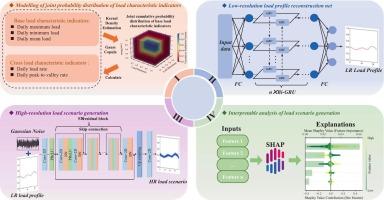一种基于LPR-Net和SRGAN的可控可解释负载场景生成方法
IF 7.1
2区 工程技术
Q1 CONSTRUCTION & BUILDING TECHNOLOGY
引用次数: 0
摘要
在电力系统规划中,准确的负荷情景生成对于捕捉不同季节条件下复杂的需求不确定性至关重要。然而,现有方法往往缺乏对场景属性的可控性,可解释性有限,难以理解负载特征指标对生成场景的影响。这些限制阻碍了需求侧管理的可靠决策。本研究旨在开发一个可控和可解释的框架,用于生成捕获复杂峰谷模式的高分辨率负载场景。首先利用核密度估计和高斯copuls建立了日负荷特征指标的联合概率模型,以捕获它们的统计依赖关系。然后介绍了一个两阶段生成框架:(i)负荷剖面重建网络(LPR-Net)确定性地从采样指标重建低分辨率负荷剖面,以及(ii)超分辨率生成对抗网络(SRGAN)通过引入现实可变性随机地将这些剖面细化到高分辨率情景。SHapley加性解释(SHAP)进一步应用于量化每个指标的贡献,增强可解释性。与单阶段生成模型相比,该方法实现了与所有季节历史负荷分布的优越对齐,以高保真度重建峰谷模式,并具有稳定的收敛性。它既能捕捉总体负荷水平,又能捕捉当日变化,同时保留指标之间的统计相关性,在不同的操作条件下显示出鲁棒性和通用性。该框架通过提供可靠的、可解释的场景来支持需求响应和储备调度,增强电力系统规划,并促进保护隐私的综合数据共享。这些能力提高了现代电力系统决策的适应性和可靠性。本文章由计算机程序翻译,如有差异,请以英文原文为准。

A novel method for controllable and interpretable load scenario generation based on LPR-Net and SRGAN
Accurate load scenario generation is critical for capturing complex demand uncertainty in power system planning under varying seasonal conditions. However, existing methods often lack controllability over scenario attributes and provide limited interpretability, making it difficult to understand the influence of load characteristic indicators on generated scenarios. These limitations hinder reliable decision-making in demand-side management. This study aims to develop a controllable and explainable framework for generating high-resolution load scenarios that capture complex peak-valley patterns. A joint probability model of daily load characteristic indicators is first established using Kernel Density Estimation and Gaussian copulas to capture their statistical dependencies. A two-stage generation framework is then introduced: (i) the Load Profile Reconstruction Network (LPR-Net) deterministically reconstructs low-resolution load profiles from sampled indicators, and (ii) a Super-Resolution Generative Adversarial Network (SRGAN) stochastically refines these profiles to high-resolution scenarios by introducing realistic variability. SHapley Additive exPlanations (SHAP) are further applied to quantify the contribution of each indicator, enhancing interpretability. The proposed approach achieves superior alignment with historical load distributions across all seasons, reconstructs peak-valley patterns with high fidelity, and exhibits stable convergence compared to single-stage generative models. It captures both overall load levels and intraday variability while preserving statistical dependencies among indicators, demonstrating robustness and generalizability under diverse operating conditions. The framework supports demand response and reserve scheduling by providing reliable, interpretable scenarios, enhances power system planning, and facilitates privacy-preserving synthetic data sharing. These capabilities improve the adaptability and reliability of decision-making in modern power systems.
求助全文
通过发布文献求助,成功后即可免费获取论文全文。
去求助
来源期刊

Energy and Buildings
工程技术-工程:土木
CiteScore
12.70
自引率
11.90%
发文量
863
审稿时长
38 days
期刊介绍:
An international journal devoted to investigations of energy use and efficiency in buildings
Energy and Buildings is an international journal publishing articles with explicit links to energy use in buildings. The aim is to present new research results, and new proven practice aimed at reducing the energy needs of a building and improving indoor environment quality.
 求助内容:
求助内容: 应助结果提醒方式:
应助结果提醒方式:


